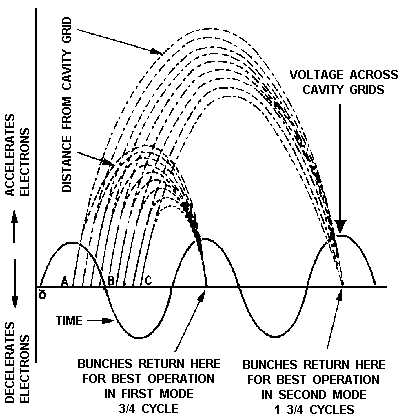
2-16
Figure 2-11.Bunching action of a reflex klystron.
The reflex klystron operates in a
different mode for each additional cycle that the electrons remain in
the repeller field. Mode 1 is obtained when the
repeller voltage produces an electron transit time of 3/4
cycle. Additional modes follow in sequence. Mode 2 has
an electron transit time of 1 3/4 cycles; mode 3
has an electron transit time of 2 3/4 cycles; etc. The
physical design of the tube limits the number of
modes possible in practical applications. A range of
four modes of operation are normally available. The
actual mode used (1 3/4 cycles through 4 3/4 cycles,
2 3/4 cycles through 6 3/4 cycles, etc.) depends upon
the application. The choice of mode is determined by
the difference in power available from each mode
and the band of frequencies over which the circuit
can be tuned. OUTPUT
POWER.The variation in output power for different modes of
operation can be
explained by examining the factors which limit the amplitude of oscillations.
Power and amplitude limitations are
caused by the DEBUNCHING process of the electrons in the repeller field space.
Debunching is simply the spreading out
of the electron bunches before they reach electrostatic fields
across the cavity grid . The lower concentration of
electrons in the returning bunches provides less power
for delivery to the oscillating cavity. This reduced
power from the bunches, in turn, reduces the amplitude
of the cavity oscillations and causes a decrease in
output power. In higher modes of operation the electron
bunches are formed more slowly. They are more likely
to be affected by debunching because of mutual
repulsion between the negatively charged electrons.
The long drift time in the higher modes allows more
time for this electron interaction and, as a result,
the effects of debunching are more severe. The mutual
repulsion changes the relative velocity between the
electrons in the bunches and causes the bunches to
spread out.

